
July 13
1863 USA: Draft riots: Three days of rioting begin in New York City by opponents of new laws passed by the United States Congress to draft men to fight in the ongoing American Civil War. [For further information, click here.]
1914 Countdown to World War I: Investigation into Archduke's assassination concludes:
Friedrich von Wiesner, an official of the Austro-Hungarian Foreign Office, reports back to Foreign Minister Leopold von Berchtold the findings of an investigation into the assassination of Archduke Franz Ferdinand, heir to the Austrian throne, and his wife Sophie the previous June 28, in Sarajevo, Bosnia.
The Dual Monarchy of Austria-Hungary had long feared its waning influence in early 20th-century Europe, and was particularly threatened after the two Balkan Wars of 1912-13 confirmed the growing influence and ambition of Serbia, backed by its mighty Slavic ally, Russia. In fact, even before Franz Ferdinand's death, Berchtold's office had been preparing a memorandum for the archduke, as well as for Germany's Kaiser Wilhelm II, proposing an alliance with Bulgaria to shore up Austrian influence and isolate Serbia in the tumultuous Balkans region. When Gavrilo Princip, a young Bosnian Serb nationalist, shot Franz Ferdinand and Sophie at point-blank range in their car in Sarajevo on June 28, Berchtold—along with most in Vienna and the rest of the world—assumed the Serbian government had some complicity in the plot. Two days after the assassination, Berchtold proposed a "final and fundamental reckoning with Serbia" to the Austrian emperor, 84-year-old Franz Josef, who agreed to send a personal note to Kaiser Wilhelm, along with a revised and more aggressive version of the memorandum. On July 5, the Kaiser gave Berchtold's ambassador what has become known as carte blanche or "blank check" assurance that Germany would back Austria-Hungary in any punitive action it chose to take against Serbia.
By July 8, both Berchtold and Conrad von Hotzendorff, the bellicose chief of staff of the Austrian army, had come to believe that a military invasion of Serbia was both desirable and necessary to capitalize on the situation and crush the upstart rival. Even as Austrian investigators worked to sort through the evidence in Sarajevo, then, Austria-Hungary, with German encouragement (in fact, Berlin was pressing Vienna to act more quickly) plotted the next step: the presentation of an ultimatum to Serbia that would be worded in such a way as to make it practically impossible for the other country to accept.
On July 13, Wiesner reported the findings of the Austrian investigation: "There is nothing to prove or even suppose that the Serbian government is accessory to the inducement for the crime, its preparation, or the furnishing of weapons. On the contrary, there are reasons to believe that this is altogether out of the question." The only evidence that could be found, it seemed, was that Princip and his cohorts had been aided by individuals with ties to the government, most likely members of a shadowy organization within the army, the Black Hand. Realizing he would have to go ahead without evidence of Serbian guilt, Berchtold declined to share these findings with Franz Josef, while his office continued the drafting of the Serbian ultimatum, which was to be delivered on July 23 in Belgrade.
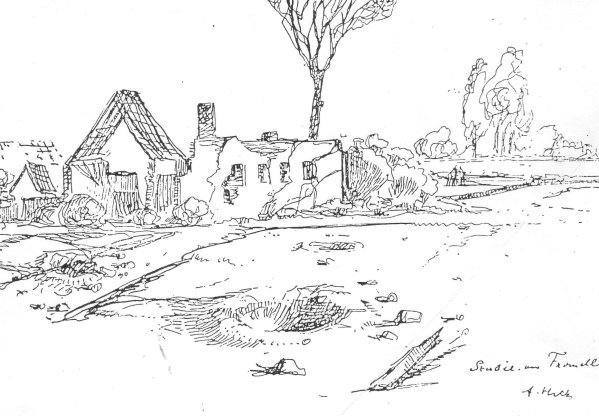
1915 World War I: List Regiment: Gefreiter Adolf Hitler's 16 Reserve Infantry Regiment continue to occupy a position at Fromelles—pictured above in a drawing by Hitler—on a level field with water channels, willow trees and willow stalks. In the distance towards the enemy lines lies an insignificant wood with barbed wire entanglements. Under the direction of their defense-minded commander, Lieutenant General Gustav Scanzoni von Lichtenfels, the regiment works ceaselessly day and night to further fortify their position at Fromelles while fighting off repeated assaults by the enemy. [For further details, Click here.]
1916 World War I: Various:
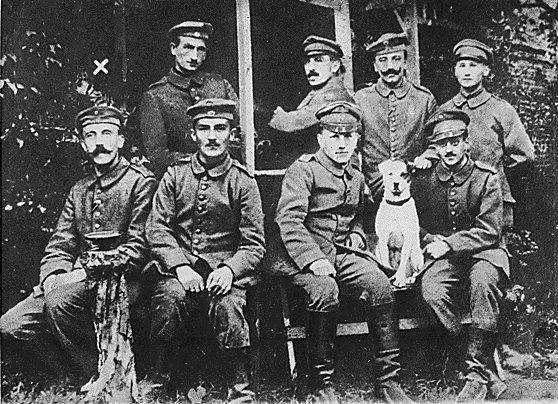
List Regiment: Gefreiter Adolf Hitler endures trench warfare in Flanders (Artois) with 3 Company, 16 Reserve Infantry Regiment. [For further details, Click here.]
Somme: The second German line in the Somme is cracked, but little advantage is gained. Britain's volunteer armies, including many 'Pals' Battalions, composed of men from the same town, had enlisted together to serve together. Their casualties were unbelievable, with entire units perishing together. The French had more artillery and faced weaker defences, and their advance was therefore far more successful. Without British backup, however, they were unable to hold the ground they had gained, and were forced to fall back.
1917 World War I: List Regiment: Gefreiter Adolf Hitler's 16th RIR remain deployed for Phase 1 operations in Flanders, Belgium. [For further details, Click here.]
1921 Birth: Friedrich Peter:
Born as the son of a social democratic engine driver and a master baker's daughter, Peter joined the NSDAP in 1938 and volunteered for the Waffen-SS at the age of barely 17. During World War II, he served at the western and eastern fronts and achieved the rank of Obersturmfuehrer in the 10th regiment of the 1st SS Infantry Brigade. This unit was part of the Einsatzgruppen which systematically shot hundreds of thousands of Jews behind the front during the summer of 1941. Although his unit was almost exclusively engaged in this activity, Peter denied any involvement or knowledge about them after the war. He was interned by American forces for a year in Glasenbach. After his release, he became an elementary school and special education teacher, later Landesschulinspektor (state school supervisor).
1931 Weimar: The failure of Danabank, a major German financial institution, leads to the closing of all banks in Germany until August 5. By the end of the 1931, approximately six million Germans are out of work. Bad news is good news for Adolf Hitler, who uses the financial situation as part of his platform.
1933 Church and Reich: The German Evangelical Church announces that it will not apply the "Aryan Clause" to its membership requirements.
1934 Hitler defends his purge of the SA in a speech at the Kroll Opera House:
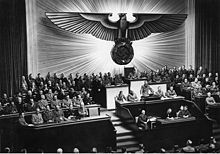
Gradually from amongst the leaders of the SA there emerged three groups: a small group of elements which were held together through a like disposition, men who were ready for any action and who had given themselves blindly into the hands of the Chief of Staff, Roehm. The principal members of this group were the SA leaders Ernst from Berlin, Heines in Silesia, Hayn in Saxony, and Heyebreck in Pomerania. Besides these there was a second group of SA leaders who did not belong to the former group in spirit but felt themselves bound to obey the Chief of Staff, Roehm, solely from a simple conception of a soldier's duty. Over against these stood a third group of leaders who made no secret of their inner disgust and reprobation and were in consequence in part removed from responsible posts, in part thrust aside, and in many respects left out of account.
[See: Hitler Kills His Best Friend.]1938 Death: Emil Kirdorf: industrialist tycoon from the Ruhr who was one of the first prominent German entrepreneurs to join the Nazis and obtain financial support for Hitler.
Emil Kirdorf, the son of a textile manufacturer, was born on the 8th April, 1847. After attending high school in Duesseldorf he joined the family business. After the failure of his father's textile company Kirdorf formed Gelsenkirchener Bergwerks, which became a very successful coal-mining firm. He later became the director of the powerful Rhenish-Westphalian Coal Syndicate.
In 1907 Kirdorf organized the creation of a fund provided by industrial magnates that could be used to fight Germany's trade union movement. During the First World War Kirdorf joined the Vaterlandspartei, an organization that favoured the territorial expansion that had been put forward by the German High Command. Kirdorf . . . first heard Adolf Hitler speak in 1927. He was so impressed that he arranged to meet Hitler at the home of Elsa Buckmann in Munich. Although Kirdorf supported most of Hitler's beliefs he was concerned about some of the policies of the Nazi Party. He was particularly worried about the views of some people in the party such as Gregor Strasser who talked about the need to redistribute wealth in Germany.
Adolf Hitler tried to reassure Kirdorf that these policies were just an attempt to gain the support of the working-class in Germany and would not be implemented once he gained power. Kirdorf suggested that Hitler should write a pamphlet for private distribution amongst Germany's leading industrialists that clearly expressed his views on economic policy. Hitler agreed and The Road to Resurgence was published in the summer of 1927. In the pamphlet distributed by Kirdorf to Germany's leading industrialists, Hitler tried to reassure his readers that he was a supporter of private enterprise and was opposed to any real transformation of Germany's economic and social structure. Kirdorf was particularly attracted to Hitler's idea of winning the working class away from left-wing political parties such as the Social Democratic Party and the Communist Party. Kirdorf and other business leaders were also impressed with the news that Hitler planned to suppress the trade union movement once he gained power.
Kirdorf joined the Nazi Party and immediately began to try and persuade other leading industrialists to supply Hitler with the necessary funds to win control of the Reichstag. Kirdorf expected Adolf Hitler to remove left-wing members of the Nazi Party such as Gregor Strasser, Ernst Roehm and Gottfried Feder to be removed from power. When this did not happen, Kirdorf switched his support to the German Nationalist Party (DNVP) led by Alfred Hugenberg.
Hermann Goering worked very hard at getting back the support of Kirdorf. However, it was only after the Night of the Long Knives in 1934 when the leaders of the left-wing of the Nazi Party, such as Gregor Strasser and Ernst Roehm were murdered, did Kirdorf rejoin the Nazi Party. Emil Kirdorf died in Muelheim on 13th July, 1938.
1939 Holocaust: Italy enacts an "Aryanization" program similar to the one in Germany.
In Norway, Denmark, the Netherlands and Belgium, members of Nazi parties play a major role in the "Aryanization" of Jewish property. The Vichy regime in unoccupied France introduces anti-Jewish policies on its own accord and later complies to a large degree with German demands for the persecution and deportation of Jews. The fascist regimes in Slovakia, Hungary, Romania, Bulgaria, Croatia and Italy follow their own anti-Jewish policies. Under pressure from their powerful ally, they also cooperate in the "Final Solution".
1940 World War II: Various:
Hitler issues Directive 15 on the air war with Britain: The offensive is to begin at full strength on August 5, with the intention of driving the RAF from the skies.
[See: Why Did Hitler Lose The Battle of Britain?]From the diary of General Franz Halder:
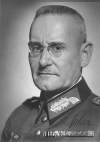
The Fuehrer is greatly puzzled by Britain's persisting unwillingness to make peace. He sees the answer (as we do) in Britain's hope on Russia, and therefore counts on having to compel her by main force to agree to peace. Actually that is much against his grain. The reason is that a military defeat of Britain will bring about the disintegration of the British Empire. This would not be of any benefit to Germany. German blood would be shed to accomplish something that would benefit only Japan, the United States, and others.
[See: What Were Adolf Hitler's Major Blunders?]1941 World War II: Various:
USSR prepares to receive Lend-Lease assistance:
Despite deep-seated mistrust and hostility between the Soviet Union and the Western democracies, Nazi Germany's invasion of the Soviet Union in June 1941 created an instant alliance between the Soviets and the two greatest powers in what the Soviet leaders had long called the "imperialist camp": Britain and the United States. Three months after the invasion, the United States extended assistance to the Soviet Union through its Lend-Lease Act of March 1941. Before September 1941, trade between the United States and the Soviet Union had been conducted primarily through the Soviet Buying Commission in the United States. Lend-Lease was the most visible sign of wartime cooperation between the United States and the Soviet Union. About $11 billion in war materiel was sent to the Soviet Union under that program.
Yugoslavia: The Communist Party initiates a general and popular uprising against Italian occupation forces in Montenegro that is suppressed within six weeks. [For further information, click here.]
1942 World War II: Various:
German U-Boats sink three more merchant ships in Gulf of St. Lawrence:
In 1942, even after the USA, under the leadership of President Franklin Roosevelt was drawn into the war, the situation actually worsened. The American navy, which had been unofficially helping out with the North Atlantic convoys since September 1941, sent most of its warships to the Pacific, and then delayed in setting up a convoy system on the Eastern seaboard. Just at that same time Doenitz dispatched a few of his rapidly growing fleet of U-boats to the waters off North America and they decimated merchant ships all along the coast from Newfoundland and the Gulf of St. Lawrence down to the Gulf of Mexico and Caribbean, where they singled out the oil and aviation fuel tankers so essential Britain's to survival.
In July, 1942, Franklin D. Roosevelt and Winston Churchill decided that the Allies should open a Second Front to help the Red Army fighting in the Soviet Union. Joseph Stalin favored an invasion of Europe but Roosevelt and Churchill opted for an invasion of northwest Africa. Given the code-name Operation Torch, General Dwight D. Eisenhower was appointed Allied commander of the invasion. Over 100,000 Vichy troops were stationed in Algeria, Morocco and Tunisia. It was hoped that the French troops would not resist the Allied invasion..
1943 World War II: Various:
Largest tank battle in history ends: The Battle of Kursk, involving some 6,000 tanks, two million men, and 5,000 aircraft, ends with the German offensive repulsed by the Soviets at heavy cost.
In early July, Germany and the USSR concentrated their forces near the city of Kursk in western Russia, site of a 150-mile-wide Soviet pocket that jutted 100 miles into the German lines. The German attack began on July 5, and 38 divisions, nearly half of which were armored, began moving from the south and the north. However, the Soviets had better tanks and air support than in previous battles, and in bitter fighting Soviet antitank artillery destroyed as much as 40 percent of the German armor, which included their new Mark VI Tiger tanks. After six days of warfare concentrated near Prokhorovka, south of Kursk, the German Field Marshal Gunther von Kluge called off the offensive.
War in the Air: Round-the-clock bombing of German cities by the Allies steadily mounts until all Germany is subjected to massive air raids.
The demands of North Africa and later the Mediterranean as well as bad weather held the level of effort down through the spring of 1943. Gradually the bombing campaign mounted in intensity and reach. Many frustrations were encountered, including difficult weather conditions, strong and resourceful German opposition, and a variety of technical and logistical limitations. The accuracy of the bombing was far worse than that which had been achieved in practice runs under less challenging conditions. Targets proved less vulnerable than had been supposed and the Germans were very quick to restore critical damage. On average, losses per raid were little higher than had been expected, but many more raids were needed than had been hoped and the losses mounted progressively.
1944 World War II: Various:
Russian front: Soviet troops approach Shauliai, Kovno, Vilna and Lublin. Many Jewish partisans are active behind the lines.
Some Jews who managed to escape from ghettos and camps formed their own fighting units. These fighters, or partisans, were concentrated in densely wooded areas. A large group of partisans in occupied Soviet territory hid in a forest near the Lithuanian capital of Vilna. They were able to derail hundreds of trains and kill over 3,000 German soldiers. Life as a partisan in the forest was difficult.
July 13-22 A Soviet Army encircles and destroys German and Ukrainian forces (including SS-Galizien division) at Brody.
For the men trapped at Brody, help would not come. Despite several desperate attacks by the exhausted and under-strength forces of XLVIII Panzerkorps and XXIV Panzerkorps, the Soviet cordon continued to tighten. Under continued Soviet attacks, Harpe ordered his forces to fall back, abandoning the trapped XIII Armeekorps. Under constant artillery and aerial bombardment, the beleaguered forces attempted several breakout attempts, but these were easily rebuffed by the Soviet armored forces and the Germans suffered heavy casualties.
New western border for the USSR:
General Ivan Konev, one of the Soviet Union's most outstanding officers, pursues an offensive against 40,000 German soldiers to capture the East Galician city of Lvov. When the battle was over, 30,000 Germans were dead, and the USSR had a new western border.
1948 Cold War: Democratic Party platform defends Roosevelt-Truman foreign policies:
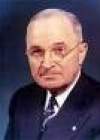
As the 1948 presidential campaign begins to heat up, the Democratic Party hammers out a platform that contains a stirring defense of the foreign policies of Franklin D. Roosevelt and President Harry S. Truman. The tone of the platform indicated that foreign policy, and particularly the nation's Cold War policies, would be a significant part of the 1948 campaign. [For further information, click here.]
1976 July 13-14 Former SS Colonel Joachim Peiper is murdered at his home near Traves, France, and his house is burned down around him. One of his arms and a leg are reported to be missing; the body can only be identified by his watch and dental records. A photograph of a group of Frenchmen wearing ski masks and posing with a sign saying "We got Peiper." will be published on November 7, 1976, in the New York Times Magazine. The attackers, suspected to be French Communists, are never prosecuted.
Edited by Levi Bookin (Copy editor) Click to join 3rdReichStudies Disclaimer: This site includes diverse and controversial materials—such as excerpts from the writings of racists and anti-Semites—so that its readers can learn the nature and extent of hate and anti-Semitic discourse. It is our sincere belief that only the informed citizen can prevail over the ignorance of Racialist "thought." Far from approving these writings, this site condemns racism in all of its forms and manifestations.
levi.bookin@gmail.com







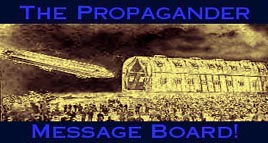


Fair Use Notice: This site may contain copyrighted material the use of which has not always been specifically authorized by the copyright owner. We are making such material available in our efforts to advance understanding of historical, political, human rights, economic, democracy, scientific, environmental, and social justice issues, etc. We believe this constitutes a "fair use" of any such copyrighted material as provided for in section 107 of the US Copyright Law. In accordance with Title 17 U.S.C. Section 107, the material on this site is distributed without profit to those who have expressed a prior interest in receiving the included information for research and educational purposes. If you wish to use copyrighted material from this site for purposes of your own that go beyond 'fair use', you must obtain permission from the copyright owner.
Please Note: The list-owner and moderators of 3rdReichStudies are not responsible for, and do not necessarily approve of, the random ads placed on our pages by our web server. They are, unfortunately, the price one pays for a 'free' website.



